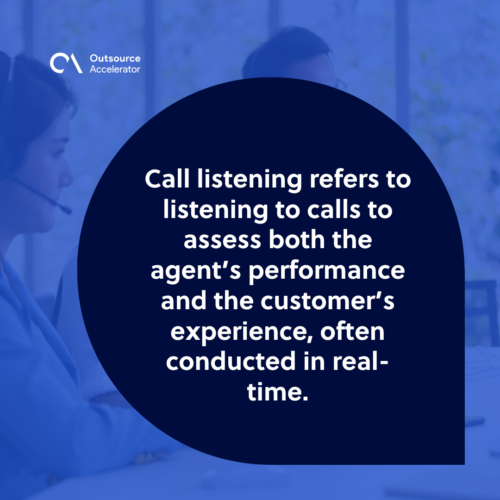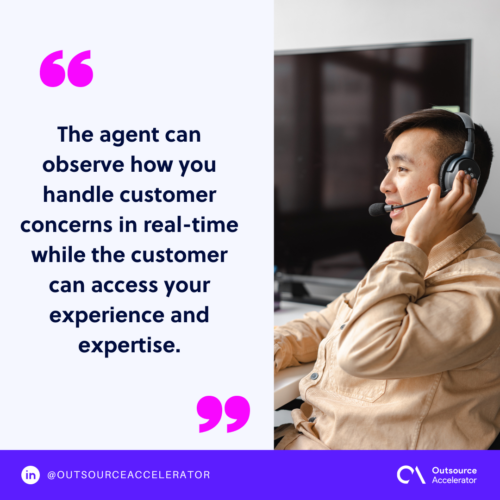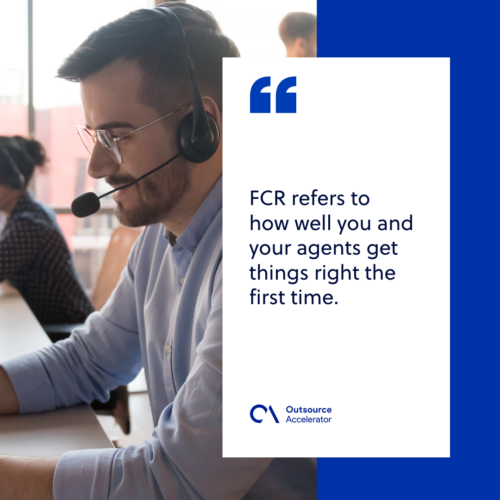Accelerate company growth with call listening

Call centers depend primarily on the customer experience (CX). Agent and team performances are often measured in terms of customer surveys, call abandonment rates, and average hold times.
However, data doesn’t always give managers and decision-makers a better view of their team’s performance; call listening does.
This practice of listening to an agent’s call is often overlooked, but when used effectively, it can drive organizational growth for your call center.
Understanding call listening
As the name suggests, call listening refers to listening to calls to assess both the agent’s performance and the customer’s experience, often conducted in real-time. It adds the human touch to a technically-oriented work environment.
For example, call records show a particular agent posting higher average hold times. Generally, this implies that customer concerns are not resolved at once or that the conversation drags unnaturally.
However, call listening might reveal that the concerned agent might have thoroughly examined the concern, made good follow-ups, or started upselling and cross-selling—which are all positive indicators.

Given this instance, call listening can be used to identify the needs of low-performing agents and help them improve. Conversely, team leads can also utilize this method to discover the secret behind their top-performing members and share best practices with the rest of the group.
By using call listening to address these gaps in your operation, you can boost your team’s performance and, more importantly, focus on providing a better customer experience.
A Salesforce research shows that 92% of consumers with a positive experience are more likely to make another purchase.
Call listening techniques
As with any organization, classifying data and access is vital. The same goes for a call center; you can listen in while limiting access to the customer, the agent, or both.
With varying involvement, each of these techniques serves a different purpose. If you’re new to call listening, it helps to know the options available to you.
Snooping
This refers to silently listening to a call once it has begun, without the knowledge of both the agent and the customer.
As such, the supervisor is expected to take no action or interrupt the call at any point in time. Similarly, this method doesn’t allow a supervisor to offer advice to an agent.
Since snooping is completely passive, this is ideal for evaluating a natural call. Agents won’t feel pressured by your presence or see the need to impress their superior.
Conversely, customers won’t feel intimidated by the presence of two or more people on the other line.
Whispering
Whispering allows a supervisor to speak to the agent without the customer knowing. This method lets you freely whisper advice or tell your team member what to do.
Whispering also works for coaching sessions, although precautions should be taken not to disclose your presence to the customer. During this call listening technique, agents are often taught to listen only and not ask questions to the supervisor while on call.
Barging in
This doesn’t refer to barging into a call in the literal sense. Instead, the supervisor will join a call with the knowledge and consent of all participants. You will participate in the call actively, making it ideal for training new hires.
This way, you can immediately step in and steer the call in the right direction. The agent can observe how you handle customer concerns in real-time while the customer can access your experience and expertise.
Aside from call listening to live calls, some BPO companies also record calls for future use.
More importantly, these two options are not separate and distinct from one another. Modern call management platforms allow you to do both: listen live and record the call. This is helpful for performance assessment and training efforts.
An important part of call listening is in notifying the customer. Aside from being considered a good practice, it is legally required in some US states to tell the caller that their call might be monitored or recorded.

How call listening benefits your business
While call listening sounds intuitive for a call center firm or a staffing agency, some organizations prefer to skip this practice in favor of fully automated solutions.
Granted, it does require additional effort from the team lead or the supervisor’s end, it ultimately serves a purpose for everyone involved.
Below are some of the key advantages offered by an effective call-listening strategy:
Assess agent competencies
First and foremost, call listening is put in place to observe a customer representative or an agent in action. Depending on which call listening method you employ, you obtain valuable insights into a particular agent’s strengths and weaknesses.
If one of your team members is struggling with specific customer interactions or delivering product-related solutions, you can pinpoint exactly what materials or training they’ll need. In doing so, you help them become better agents.
Gartner’s 2022 survey revealed that HR leaders primarily focused on enhancing employees critical skills and competencies.
More importantly, it keeps your team members a part of your changing strategies. Investing in your agents and keeping them in the loop makes them feel valued. It gives them a better appreciation of their role, which incentivizes them to help in customer retention.
Identify CX gaps and opportunities
Beyond improving your agent’s competencies, call listening also provides a unique opportunity to examine caller behavior without having to take calls yourself. To create a better customer experience, it is imperative to remain aligned with their concerns, priorities, and needs.
Call listening is particularly helpful in identifying negative trends or root causes for recurring problems.
For example, a trend of dissatisfied customers could be better understood by listening to a call or two. In doing so, decision-makers can identify gaps in their current CX design strategies or realign their products and services.
Gain access to insights for KPI monitoring
As mentioned earlier, sometimes the data gathered doesn’t tell a complete story. Listening to a call helps provide insight into emerging trends in the call center, whether positive or negative. It allows the leadership to make correct decisions.
Generally, staff performance is measured using various key process indicators (KPIs) such as the following:
Average handle time (AHT)
Generally, shorter AHT means the agent resolves customer inquiries fast. However, it’s not as simple as aiming for shorter handle times for everyone.
Call listening could reveal reasons for extended calls, such as excellent agent follow-ups that open opportunities for upselling or cross-selling other products.
Customer satisfaction (CSAT)
Simply put, customer satisfaction is a KPI that quantifies how happy the callers are with your service. This is often captured through customer surveys or feedback channels.
With call listening, you can access the entire conversation that led to a particular CSAT rating. More importantly, call listening gives you a picture of how a particular agent’s calls usually proceed.
It can be tied to that member’s average CSAT scores. You can also use the insights from the call to examine whether the survey questions are aligned with your business objectives as well as the customer’s needs.
First contact resolution (FCR)
FCR refers to how well you and your agents get things right the first time. This KPI measures the frequency of caller inquiries resolved from the first time they connect with your team, hence, the resolution at first contact.
A private study establishes a positive link between higher FCR numbers with customer satisfaction levels.

To drive higher FCR stats, leaders are inclined to focus on resolving queries at first contact. Call listening is an essential step since it helps supervisors identify gaps that cause customers to call again.
Also, it could identify if other factors are at work, such as the customer only calling for confirmation or follow-up. It’s also possible that the customer calls without ample information, requiring them to get back to your agents some other time.
Drive timely intervention
The different forms of call listening can all help enable timely intervention. When used correctly, they can prevent an issue from escalating or nip an emerging negative trend from the bud.
The most passive of them, snooping, allows you to observe calls often without alerting the agent. This provides insights into their natural performance and could identify strengths and weaknesses, including those they might not notice themselves.
With whispering, you can tap into the agent directly. It has various applications on the floor, but all are focused on walking an agent through a call.
Whether resolving a customer query or rolling out a new item from product development, they can navigate unfamiliar situations more easily with a supervisor.
Lastly, barging in announces your presence to both the agent and the customer. For agents-in-training, they get to familiarize themselves with an actual call environment without the risks of going off on their own.
Setting up robust call listening practices
In any call center, listening is key. Agents are expected to respond to their customers actively, and supervisors are also expected to listen to their team members.
Various call listening strategies help you gain the insights you need, whether it’s about the customer, your agent, or the company’s system in place.
Adopting this established practice ensures that your operations remain relevant in the face of changing customer needs. In doing so, you improve both employee and customer satisfaction, ensuring they stay with your team in the long run.







 Independent
Independent




